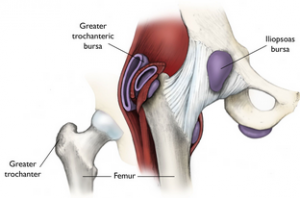Bursitis can affect the hips, knees, elbows, shoulders, and even the balls of the feet. Anywhere there is a fluid-filled sac, that has been broken or damaged, will cause bursitis. In this article, though, we will focus specifically on the hips, and how to relieve the pain of hip bursitis.
Millions of people have bursitis through various types of injuries. Working a lifetime standing on concrete floors, sports injuries, falls, repetitive hobbies, and many other events and activities can cause the sac cushioning the joint area to become inflamed. When that happens, the bones and tissues just grind on one another causing immense pain.
 The sac is called the bursa and more than one are bursae. It is hard to believe, but there are nearly a couple hundred in the human body. The inflamed ones, in the hip area, cause Trochanteric Bursitis.
The sac is called the bursa and more than one are bursae. It is hard to believe, but there are nearly a couple hundred in the human body. The inflamed ones, in the hip area, cause Trochanteric Bursitis.
Some call it iliopectineal bursitis, but in fact, the two bursae are on opposite sides of the hips. The pain from iliopectineal bursitis occurs in the groin area and this condition is much less common than trochanteric bursitis.
One of the worst things about this condition is there is no cure. They cannot magically repair the bursa, but you still must find some comfort from the nagging pain. And, that’s where we will help you, by explaining how stretching for relief of trochanteric bursitis is a legitimate and recommended treatment.
For different people, the pain is activated in a variety of ways. For example, when lying on one side of the body when sleeping, there may be no problem, but on the other side, it is unbearable to stay in that position. Oftentimes, the only relief is to get out of bed and stretch.
A firmer, thicker mattress may also help, although this tends to be expensive, while stretches to reduce hip pain are available to everyone.
Typically, you can get the pain under control, and for some time you forget about the bursitis, but then you will do something, like wash the floors on your hands and knees, and it will flare up again with a vengeance.
Shoveling snow, gardening, raking, and standing for long periods of time can be problematic, too, as they all exert pressure on the same parts of the body with each motion. For some individuals, the condition actually prevents them from doing the things they enjoy.
That’s why it is all the more important to learn a few stretches for relief of trochanteric bursitis and keep at it consistently.
How to Stretch Out Hip Bursitis
#1 Essential Stretch for Relief of Trochanteric Bursitis
Hip flexors or hip rotator stretches can help to stretch out the hip area and ease some pain. They should be done gently and without intensity.
#2 Essential Stretch for Relief of Trochanteric Bursitis
The clamshell is very easy to do. Lie on your side with a pillow under your ear. Open and close your legs at the knee. The movements are to be done slowly and gently. Hold for a few seconds, when the legs are fully open. Again, vigorously opening and closing is not the aim here.
#3 Essential Stretch for Relief of Trochanteric Bursitis
If you feel strong enough, you can try some full leg raises. Lie on your side again and stretch the legs out straight. Prop your head up with your elbow. Now lift your top leg about a foot apart from the other leg. If you can, hold for a few seconds.
Admittedly, this one is harder to do, so as in the other exercises, go slowly and methodically. Only do what you can without pain.
But, all three of examples are effective stretches to help with hip pain. The key is not to cause yourself more pain. Just do as many repetitions as you comfortably can.
In fact, on the first day, start with only a couple, and move yourself up as you can as the days go by. Ideally, these techniques should return normal movement to the joint.
How to Treat Bursitis in the Hip at Home
Of course, you’ll want to establish a routine of stretching for relief of trochanteric bursitis but, we have also listed other treatments that do not require prescriptions or invasive surgeries.
- Avoid the activity that caused the bursitis in the first place. Once you are rested up, you can resume it and see what happens.
- RICE is often prescribed for immediate traumatic injuries. Rest, Ice, Compression, Elevation
- For an injury that has happened previously, and one that is caused from continual, repetitive motion, heat will usually provide some instant relief. Either a warm compress or if you own a heating pad, that is even better.
- Likewise, an electric blanket can help, and even a warm bath. Just be careful with having a bath because the pain may be so bad you won’t be able to get out of the bathtub by yourself.
- For the elbow or shoulder, a sling might help, so that you are not jostling it all around, irritating it and making the pain worse.
- For the knee, a splint to keep it from moving, but then this requires you to remain still.
- Consider buying new shoes. Ill fitting shoes and shoes that are worn out is a common cause of bursitis in the hips. The feet should be supported in the shoes so that the hip moves properly. Also, if one leg is a tad shorter, buy corrective inserts so that the difference is removed.
- For long term cases, physical therapy can help, as well. Most likely, you will need to get the exercises first from the PT, but then you can carry on at home by yourself.
- Likewise, in some extreme circumstances, a cane, walking stick, it crutches might help to move about. They won’t, however, do anything for the pain.
How to Get Rid of Hip Bursitis Naturally
There are some other remedies that can be used in conjunction with stretching for relief of trochanteric bursitis.
- Tumeric, which some chefs use in place of saffron, has shown promise for pain relief, as it acts as an anti-inflammatory.
- Black strap molasses have also been used, as they provide much needed magnesium.
- Rubbing ginger oil on the sore hip has helped many individuals find relief.
- Other suggested food items are cayenne pepper, flaxseed oil, vinegar mixed with honey, spinach, kale, cabbage, blackberries, grapes, pineapple, and nuts.
Regardless of what you may or may not choose to do when asking how to get rid of bursitis in the hip, remember that a consultation with a medical practitioner may be in order.
Additionally, when using homemade remedies or even those sold over the counter, the dilemma is knowing how much to use, and how often, to really see any positive results.
Needless to say, eating nutritionally goes a long way to improving many conditions.
How To Avoid Hip Bursitis When Running
Your shoes are going to be one of the most important aspects when running, whether you have bursitis or not.
You don’t necessarily have to buy the most expensive running shoes, but you do need styles that are supportive, comfortable, and shock-absorbent.
Remember that your feet are pounding on the ground every time your legs go up and down. This can not only take a toll on the knees and ankles, but also the hips.
This is another reason that warm up stretching for relief of Trochanteric Bursitis is recommended before starting your daily jog or sports activity.
And, if you already have a flare-up of pain in the hip, you are not going to cure the bursitis at all. In fact, running will be one of the worst things you could do for treatment.
It is common for athletes that are required to run for their sport to suffer from bursitis, simply because of the repetitive overuse of the joint.
Final Thoughts on Stretches for Relief of Trochanteric Bursitis
Indeed, it is quite common for all kinds of individuals to suffer from bursitis. The difference is in the severity of the pain, and why it flares up in the first place.
While we admit that there are many treatments for this condition, we do know that whatever path you choose, adding a regimen of stretching for relief of trochanteric bursitis will undoubtedly improve your recovery efforts.
